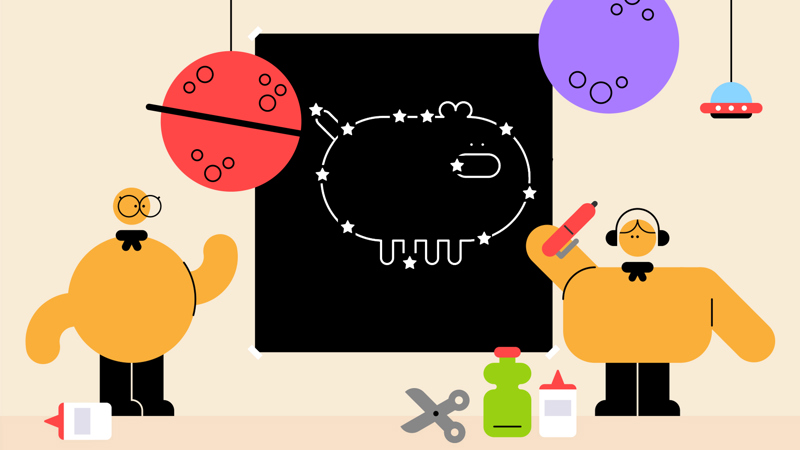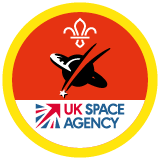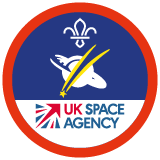
Create a star map
You’ll need
- Tables
- Chairs
- Compass
- Access to the internet
- Pens or pencils
- Craft materials, including paintbrushes, scissors, black paper/card and glow-in-the-dark paints
- Painting trays
- Re-purposed materials, including old toothbrushes, black bed sheets/pillowcases and newspaper
- A red bicycle light or head-torch light
- A map of the local area
Before you begin
- Use the safety checklist to help you plan and risk assess your activity. Additional help to carry out your risk assessment, including examples can be found here. Don’t forget to make sure all young people and adults involved in the activity know how to take part safely.
- Make sure you’ll have enough adult helpers. You may need some parents and carers to help if you’re short on helpers.
Setting up this activity
- Make sure you have enough black bed sheets, pillowcases and glow-in-the-dark paint to share between small groups. Each group needs two ‘sheets.’ Consider cutting the bed sheet into quarters or cut the pillow cases in half to make more use of the materials.
- Have a look at Astronomy Now or Sky Map Online for some star maps. Each group needs two different star maps, from different locations at different times, so that it’s clear what factors affect the stars we can see. Print off the chosen maps, making a note of the times and locations they were taken from.
- Before the session, encourage everyone to come to the meeting in old clothes that they don’t mind getting some paint on.
- Set up the meeting place. Set out tables and chairs and put out two star maps and two sheets, as well as paints, brushes and trays. Put newspaper on the table to protect them whilst painting.
Maps at the ready
- Gather everyone together.
- Explain that the sky at night changes throughout the year as the world rotates and orbits around the sun. Depending on where we live in the world different stars can be seen. Tell everyone that they'll be discovering star maps, different constellations and how the patterns of the stars change by creating their own star maps.
- Before getting started on the maps, talk with everyone about the differences between star maps and a map of the local area.
- A star map is sometimes known as a star chart or astronomical map. It’s a celestial (universe) map of the night sky with astronomical objects, such as planets, stars and moons, laid out on a grid system. They’re used to identify and locate constellations, stars, nebulae, galaxies and planets, as well as to help people to navigate. The stars have been used for human navigation throughout time.
- Divide everyone into small groups and ask them to each find a space or to wait at a table.
- Put the map of the local area on each table. Ask everyone to spend time looking and talking about the different look of the maps, the scales, different symbols and why they need to be so different because of what they’re mapping.
- Everyone should take turns to try and read one of their star maps using a compass, while the discussion of maps is going on. Orientate the star maps and mark north with a pencil. While one group uses the compass, another should look at their star map with a red light, which helps you see in the dark. If possible, they could try this in a darkened room.
- Now, each group should use paint brushes to paint a large circle on each of their sheets. This needs to be big enough to fit all the stars on their maps in.
- Someone should also paint the time and location in a corner of the sheet outside the circle, if this is displayed on the map.
- Have everyone begin painting the stars from each of their maps onto a circle. Groups should divide up the work evenly.
- Go around and see if anyone has noticed familiar constellations and stars on their maps. Discuss how they’ll be represented in the circles.
- When everyone’s finished painting their maps, the sheets should be left to dry.
- In this time, you could go outside and look at the stars with the red light, if it’s clear/dark enough.
- As the paint dries, have each group prepare to present their maps to everyone. They should be able to say when each map was from, where the stars could be seen from and which familiar stars and constellations are visible.
Lights out
- When all the paint has dried, move aside the tables and chairs, so that there’s floor space. Lay out the sheets on the floor and turn off any lights.
- Everyone should look at the maps in the dark. The paint should make the stars and constellations visible.
- Have groups take turns to point out the time, location and features of their maps. Allow some time for questions after if anyone has any and then move onto the next group.
- Encourage everyone to say something about the map or point towards any constellations being spoken about.
Reflection
The sky at night changes all the time as the world rotates and orbits the sun. Depending on where we live in the world different stars can be seen. This activity allowed everyone to look at star maps, find different constellations and see how the patterns of the stars change by creating their own star maps. With all this in mind, ask the group this. Why might an astronomer in Australia see a different set of stars to an astronomer in the UK? Remember, Australia is in a different hemisphere and time-zone.
People used to use the stars to navigate. Stars like the North Star and constellations like the Southern Cross were important beacons that helped people find their way home. Why might it still be useful to know about these stars and constellations? Bear in mind that you don’t always have a map and compass with you, but the stars are always there in the night sky.
Safety
All activities must be safely managed. You must complete a thorough risk assessment and take appropriate steps to reduce risk. Use the safety checklist to help you plan and risk assess your activity. Always get approval for the activity, and have suitable supervision and an InTouch process.
- Outdoor activities
You must have permission to use the location. Always check the weather forecast, and inform parents and carers of any change in venue.
- Scissors
Supervise young people appropriately when they’re using scissors. Store all sharp objects securely, out of the reach of young people.
- Rubbish and recycling
All items should be clean and suitable for this activity.
- Dark
Provide some light, so the environment isn’t completely dark. Everyone must be able to see others and move around the area safely.
Ambitious groups with a red light and a compass could try finding north on their star maps in the dark. Help groups find north where necessary.
You could print off maps that link together and have the groups attempt to fit them together like a jigsaw, once they’ve been painted. Take care if you decide to do this in the dark!
Have gloves available for those who need or want them.
Make sure everyone has everything they need to complete the tasks in this activity. Bear this in mind when splitting off into groups.
All Scout activities should be inclusive and accessible.
Go out into your local community and find somewhere that you can see the stars. This can be a local park or playground but try to find somewhere as dark as possible. Have a look at the stars and compare what you can see to the star maps you created. Are there any similarities? What constellations can you find in the sky that you remember talking about when looking at your star maps?
This activity and badge can count towards a CREST award.
Allow the young people to research into different star maps for the other teams. Encourage them to find locations from all over the world so that everyone can see different star patterns and constellations.

